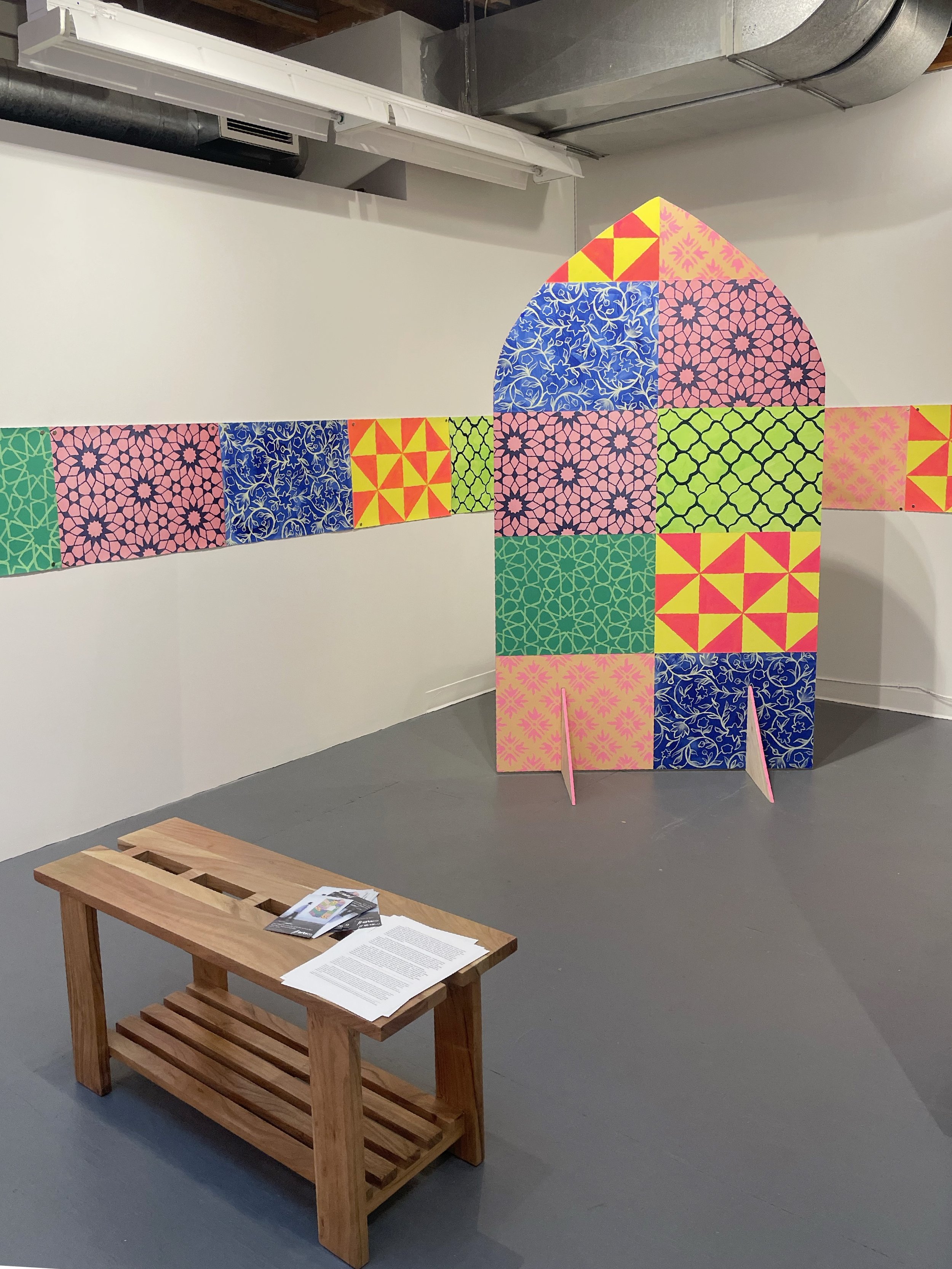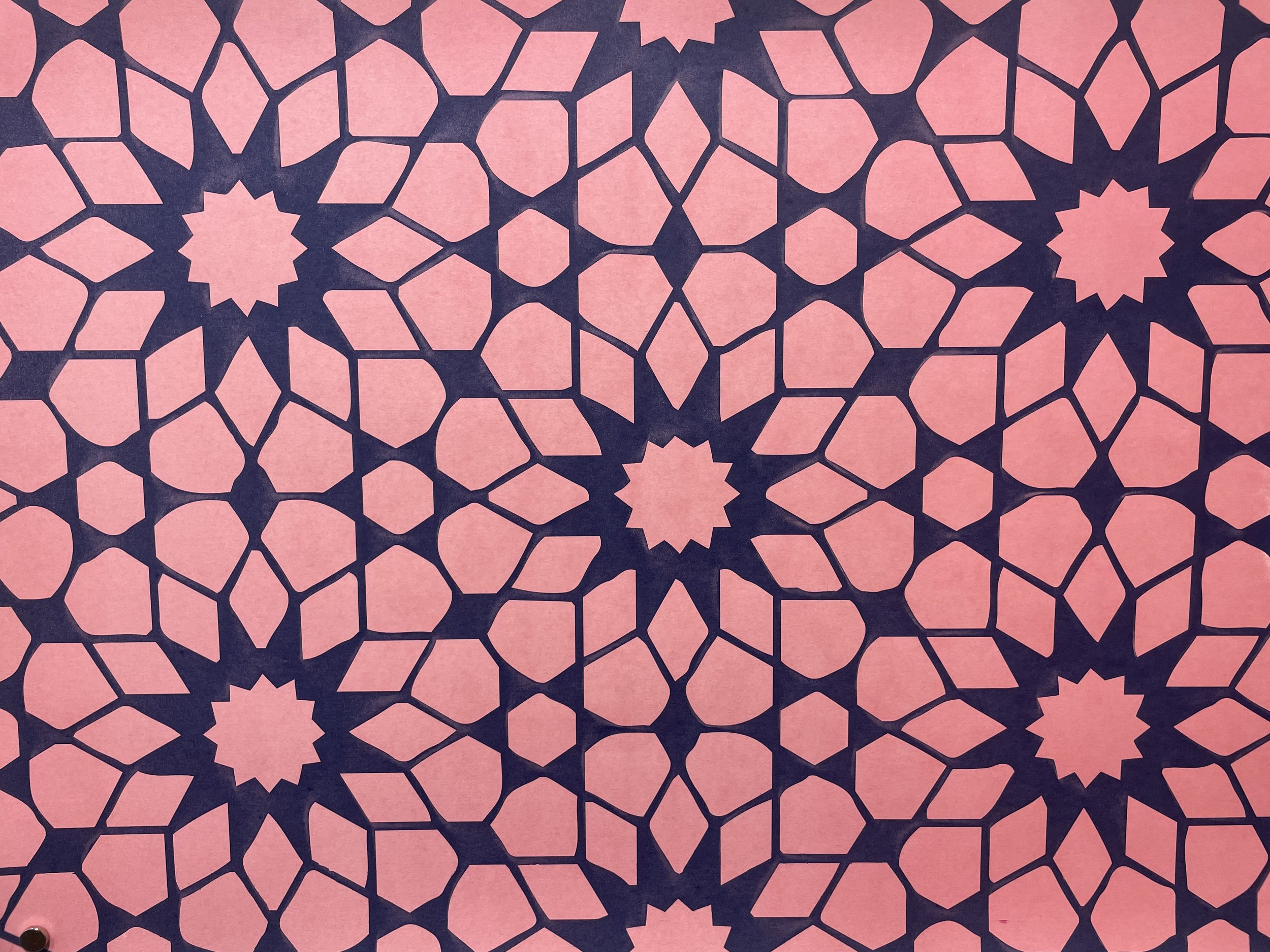ARTSCO Community Gallery
September 14th - October 14th, 2023
one thing is certain and the rest is lies is a continued exploration on navigating Queer culture as a person connected to the Iranian diaspora in so-called Canada. My practice involves connecting with my Iranian heritage through traditional forms of art such as Persian miniatures, Mughal miniatures, and illuminated manuscripts. Persian miniatures, which were often created to accompany stories and poetry, included common visual elements such as intricate patterns, high horizon lines, symbolic fauna and flora, flat 2D compositions, skewed perspectives, and disruptive architecture. I describe these architectural elements as “skewed” and “disruptive” as the perspectives often lack visual rationality through flatness and a lack of vanishing points. Using these formal visual elements and the poetic nature of the source material as a reference point, I aim to bring these illustrations into a physical space through interdisciplinary practice. My intentions are to disrupt these traditional forms to establish an intimate space as a means of queering these spaces.
By queering spaces through imagery derived from traditional Persian miniatures, I critique the ongoing humanitarian crisis in Iran. These historical artifacts often told poetic stories of royalty, love, battle, and allegory through a gaze where it uplifted the powerful people who commissioned these works. This practice was also controlled by the schools or guilds that taught such artistic forms, thus limiting these narratives and who could share them. This interests me as it resembles the historic and current exclusion of queer narratives in art, culture, history, and in many societies. I relate this to the ways Queer people are invalidated, erased, and willfully disregarded by the current government of Iran, the contemporary location from where much of this historic practice derives.
To “queer space”, I allude to how Queer identity demands openness, fluidity and re-imagining heteronormative constructs. Designer and architect Jaffer Kolb comments on queerness as, “an open mesh of possibilities, gaps, overlaps, dissonances, resonances, lapses and excesses of meaning.” With that in mind, I attempt to render the ethereal illustrations and poems from traditional sources in a contemporary and physical space. By transforming the metaphorical architectural constructs that surround us, I assert queerness to counter dominant structures that seek to invalidate and erase queer narratives. Allied to this spatial investigation I consider the diaspora of Iranians who have fled, and are fleeing, for safety and freedom. This work reflects on culture, tradition, queerness, and the ongoing displacement of queer Iranians or the methods in which queer Iranians and other marginalized groups navigate existing in oppressive spaces.
Artist Interview
Kirsteen McCulloch: How did this current body of work develop? Did it evolve from previous work?
Moozhan Armadzadegan: The last few years I have been looking to my heritage as an Iranian to guide my practice. I spend lots of time looking at Persian miniatures and Mughal miniatures and they have served as a big influence in my practice as of late. With this work, I aim to pull architectural elements depicted in these manuscripts and bring them into a physical space.
K: These works are on a larger scale, how do you feel this serves to the viewer? And how did it feel working this scale in the studio?
M: I don't typically work with such scale, but with this work it felt important that they really occupied space. I wanted the viewer to feel like they were in a space that has been transformed, where their body and artwork are similar in size, and where the scale and composition of the installation invites the viewer to move around the work. This was also a fun challenge for me to work more sculpturally and consider space and size. My studio is quite small so normally I can't work at this scale, but these works were created while I was on residency in Victoria with the BMK residency, where I had 2 months of committed studio time to really explore and play.
K: What was the process in creating these works?
M: I begin sourcing elements such as patterns, architectural elements, and even poetry from Persian miniatures. I then recreate these patterns through painting and printmaking techniques, and apply them to the plywood structures I have cut to shape. There is a bit of research and prep that goes in before I begin, but as I get going I follow my intuition and explore what feels right in the moment.
K: Are there any artists you were influenced by?
M: There are lots, but a few that stand out are Sandeep Johal, Shirin Neshat, Xavier Schipani, David Hockney, Njideka Akunyili Crosby, Tania Willard
K: Where do you see your work going next? Any future goals?
M: I hope to keep building upon this body of work and see where it goes. Eventually, I'd like to go back to school for a Masters of Fine Arts.
Artist biography:
Moozhan Ahmadzadegan is an emerging artist based on the unceded and traditional territory of the Syilx Okanagan people, Commonly known as the Okanagan. He received a BFA from the University of British Columbia Okanagan with a Major in Visual Arts and a Minor in Art History and Visual Culture in 2019. His work has been exhibited in artist-run centres and public art galleries such as the Alternator Centre for Contemporary Art, the Fifty Fifty Arts Collective, and the Kelowna Art Gallery. In 2021 he was awarded the UBC Alumni Builder Award and selected for the BC Arts Council Early Career Development award under the mentorship of Tania Willard. Moozhan is also co-founder of the Laundry Room Collective; an artist-run collective that works to provide accessible arts and culture programming, support emerging artists, and foster diversity and inclusion in an effort to meaningfully contribute to his community.
Moozhan’s practice engages personal and social inquiry as a means to navigate themes of identity, queerness, Iranian diaspora, and cultural inbetweeness. This spectrum of ideas informs the basis of his practice and serves as a point of access to deepen his understanding of contemporary social issues within art. Moozhan’s practice often explores Persian miniatures, reconciling illustrative styles within contemporary art, and experimenting with materiality. He engages the mediums of painting, screenprinting, textiles, found-objects, lights, and more recently plant-based installation. These visual tools explore his curiosity of how we respond and engage with the colonial social and cultural structures that impact identity on personal, national and public scales.







